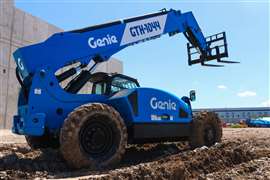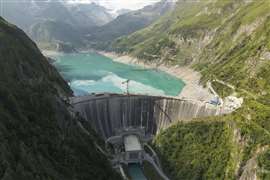Read this article in Français Deutsch Italiano Português Español
Turbulence ahead: What challenges does airport construction face?
13 August 2024
Airport construction is progressing, but various obstacles hinder completion. Catrin Jones examines these challenges and how some projects have surmounted them.
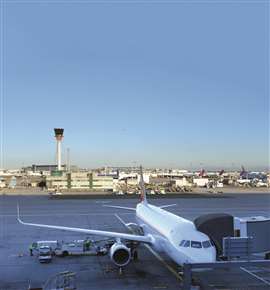
In recent years, Europe has seen a rise in airport construction projects designed to modernise old infrastructure and meet the growing demands of air travel. However, these efforts have faced numerous challenges, from bureaucratic hurdles to environmental concerns.
It has been widely recognised that airport construction on the continent failed to keep up with the increasing demand before the outbreak of the coronavirus pandemic. This, combined with inefficient airspace control, resulted in the possibility of capacity crunches, significant travel delays, and even the risk of passengers being unable to fly to their desired destination on their desired day.
According to the CAPA Centre for Aviation, there are 177 known infrastructure projects at European airports, with a collective investment value of €100.1 billion (US$109 billion).
One of the most significant problems encountered by airport construction projects across Europe is the complex regulatory processes and bureaucratic red tape. The lengthy and complicated approval procedures often lead to significant delays and inflated costs.
Increased expenses
A good example is the expansion of London’s Heathrow Airport in the UK, one of Europe’s busiest hubs, which has been stuck in a lengthy legal battle over environmental concerns and airspace congestion, hampering progress and increasing expenses.
The plans to expand Heathrow Airport with a third runway were put on hold at the beginning of the Covid-19 pandemic. Four years on, the project is still officially “under review.”
The former CEO of Heathrow Airport, John Holland-Kaye, has emphasised that the expansion project should remain a top priority for the new CEO. During his tenure, Holland-Kaye played a key role in developing the plan for Heathrow expansion, which was approved by Parliament. He continued to support the proposals until he departed from the position in 2023.
When Holland-Kaye announced that he was to stand down as chief executive, he told UK-based newspaper The Independent, “We are still committed to expansion. We have already started some of the preliminary work on expansion now that we have started to have the bandwidth to do that.”
Mitigating challenges
Logistical challenges such as material sourcing, transportation and onsite coordination can be obstacles when working towards timely project completion but there are ways around it.
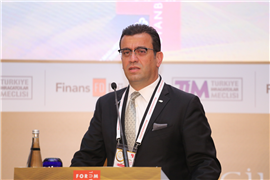 Mr. Hakan Öztürk (Photo: Limak)
Mr. Hakan Öztürk (Photo: Limak)
Turkey-based construction engineering company Limak Construction, which worked on the construction of the huge new airport in Istanbul, also won the largest ever contract for a Turkish contractor outside of Turkey, when it was selected to build the new terminal at Kuwait airport.
Hakan Öztürk, the CEO of Prishtina International Airport in Kosovo, an airport operated by Limak, says that to overcome challenges they procure materials from trusted, long-term suppliers to minimise the risks of delays and shortages.
“While we utilise local and global suppliers to manage costs and ensure timely availability, unforeseen circumstances can still pose challenges to our planning.
“To address this, we implement robust logistics planning that includes contingency strategies, such as potential multi-modal transportation arrangements, to navigate unexpected delays or transportation issues. Additionally, we leverage various project management tools and technologies to coordinate team scheduling and track progress, ensuring seamless onsite coordination and timely project completion.”
Öztürk adds that when feasible and beneficial, the company also establishes onsite fabrication facilities. He says, “This gives us greater control over the production required for the construction programme and streamlines the supply chain to materials only.”
Rising costs
Airport construction and expansion are exceptionally costly, and the pandemic has caused many to question whether further investment is safe, or beneficial to the environment.
There has been a recent slowdown in plans to expand several airports across Europe because of the contribution flying makes to climate change. Two significant decisions – one in Vienna and the other in London – are said to indicate that commitments to reducing greenhouse gases are prompting some to rethink the benefits of airport growth.
Environmental considerations are a major concern when it comes to airport development initiatives. The building and expansion of airports often intersect with ecological hotspots, triggering vehement opposition from environmental activists and local communities.
In response to worries surrounding the impact to the environment, Öztürk and the rest of the Limak team have found innovative construction methods to enhance airport construction efficiency, safety and sustainability.
Öztürk says that they employ state-of-the-art Building Information Modelling (BIM) technologies to elevate the precision of Limak’s construction planning and execution.
“Notably, our implementation of BIM at our Kuwait Project, which features a new terminal spanning over 700,000m², stands as one of the largest applications of this technology.”
Signed and confirmed for build in 2016, Limak Construction was awarded the tender for the construction of the Kuwait International Airport New Terminal building (KIA-T2).
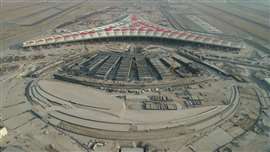 Kuwait International Airport (Photo: Limak)
Kuwait International Airport (Photo: Limak)
Working alongside architecture company Foster & Partners, Limak’s KIA-T2 project aims to be a LEED GOLD building, producing solar energy by combining the thermal properties of the concrete construction with roof-mounted solar panels.
Öztürk highlights that for heightened efficiency on a larger scale, Limak embraces modular construction techniques.
“This approach facilitates the offsite fabrication of airport components, subsequently streamlining onsite assembly processes. The result is a reduction in construction duration and disruption.
“In alignment with sustainability goals tailored to the airport construction industry, we prioritise the use of eco-friendly building materials and energy-efficient systems. Moreover, at each project site, we institute and monitor a comprehensive programme for recycling construction waste.”
A lifecycle approach
Gurjit Wood, former lead of Arup’s Aviation business in the United Kingdom, India, Middle East and Africa, highlights that, as in other resource-heavy infrastructure, airports could shift to a 360-degree lifecycle approach to the design, construction and operation of new and existing physical assets.
She says, “This would enable them to embody a circular economy approach to their built assets, adopting materials passports and other measures to enable the reuse of materials when facilities reach the end of their life, lowering lifetime emissions and retaining the value of building products and assemblies as a result.
“In [Arup’s] work with one leading airport, our assessments were able to identify 8,500 sq m of existing concrete pavement that could be retained and reused from upgrade works. It is a matter of adopting a different mindset and anticipating re-use wherever practical.”
The Airport Carbon Accreditation scheme by ACI, along with the introduction of new government regulations such as the decarbonisation plan proposed by the UK government and the European Union’s Green Deal proposals, are playing a crucial role in shaping the rapid changes needed to reduce waste and embodied carbon. These initiatives are also setting stringent targets for the procurement of renewable energy.
Wood says that governments can also establish a lifecycle cost assessment for airport projects, so operators understand how to achieve net zero on existing as well as new buildings. She emphasises that net zero is possible but must be approached in an integrated way, from multiple operational angles.
Beyond the challenges
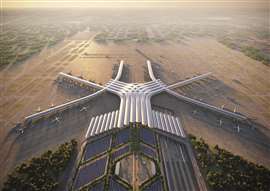 Poland’s Centralny Port Komunikacyjny (CPK) (Photo: Foster + Partners)
Poland’s Centralny Port Komunikacyjny (CPK) (Photo: Foster + Partners)
Another major airport project facing challenges is Poland’s Centralny Port Komunikacyjny (CPK).
CPK is a planned transfer hub between Warsaw and Łódź in Poland, which will integrate air, rail and road transport. The new international airport will be constructed from scratch and located in the suburbs of Warsaw.
Covering an area of approximately 400,000 sq m, the passenger terminal will be situated on two levels and be connected to four modular piers, which can be expanded in the future to meet market demands.
Poland’s new government announced a pause and “audit” earlier this year. Opponents of the new central airport argued that the construction costs would be too big of a burden for the government’s budget.
Developers expect the construction of the airport to cost in the region of €8.4 billion, but this figure could increase to as much as €27.5 billion once wider costs are included.
The government’s new approach emphasizes an audit of the CPK project instead of halting it, allowing for more political flexibility in deciding whether the project is necessary for Poland and Europe.
Expansion ahead
The COVID-19 pandemic has caused delays in construction projects all around the world, leading to a significant setback in the development of airport infrastructure.
However, there is encouraging news that investment in airports is increasing, and plans are underway to upgrade other European hubs as demand continues to grow.
Limak’s Öztürk knows that there is still turbulence ahead and highlights that there is a growing emphasis on stringent environmental regulations and the need for resilient infrastructure that can withstanding the impact of climate change.
In addition to this, he says, it is also necessary to bolster compliance processes and introduce more technology to the construction process, to make projects more efficient and sustainable.
“A key challenge,” he says, “is the escalating significance of integrating digital technologies such as AI into construction processes.
“We also anticipate that collaborating with relevant industry stakeholders, including strategic partnerships with technology firms and academic institutions, will continue to grow in significance for our industry.”
STAY CONNECTED


Receive the information you need when you need it through our world-leading magazines, newsletters and daily briefings.
CONNECT WITH THE TEAM









